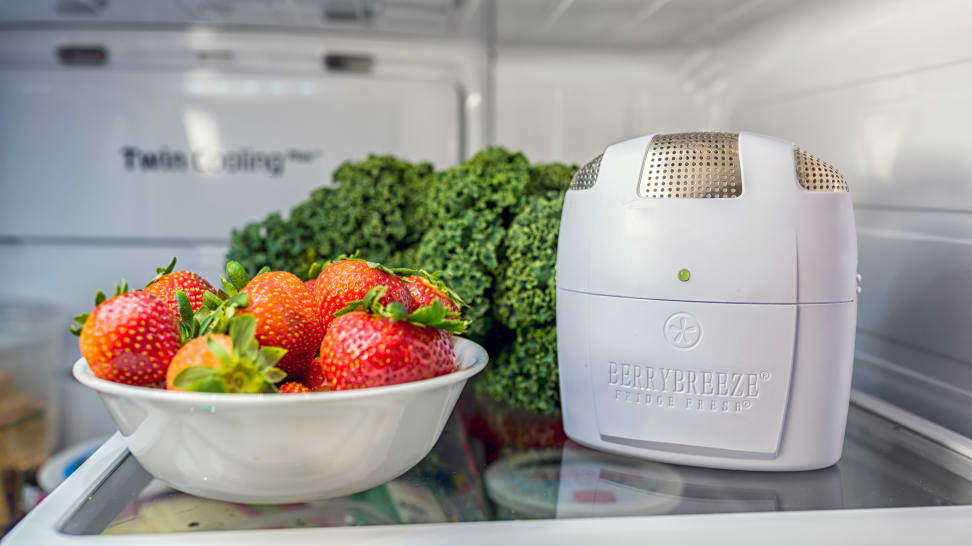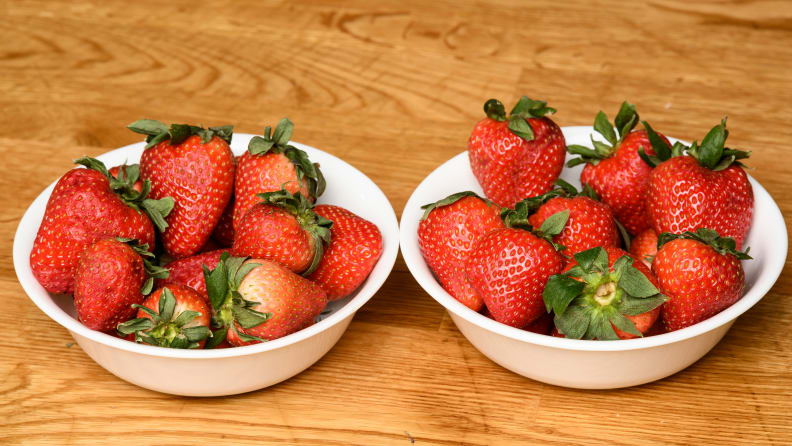This $30 gadget could save you hundreds on groceries
Say hello to your refrigerator's new best friend.
 Credit:
Credit:
Products are chosen independently by our editors. Purchases made through our links may earn us a commission.
If you find yourself tossing the spinach, strawberries, and tomatoes you bought on your last grocery trip in the trash before finishing them off, you’re not alone—according to the EPA, Americans throw away an average of $1,600 in food per year, much of which is produce.
While mindful shopping and intentional eating are steps in the right direction towards reducing this unsustainable habit, one company thinks they found a simpler solution with the Fridge Fresh ($29), a small device that uses “activated oxygen,” also known as ozone, to prevent bacteria growth and prolong the fridge-life of fruits and vegetables. Just load it up with batteries, place it on the top shelf of your refrigerator, and get more food for your money. The ozone neutralizes bad odors and the ethylene gas that causes foods to ripen, too.
If you think this sounds too good to be true, we had the same thought—so we tested the Fridge Fresh for over a month to see if it actually worked. In the end, we were pleasantly surprised by what the little thing was capable of.
What the Fridge Fresh claims to do

The mission of the Fridge Fresh is simple: to save the environment, and your wallet, from the scourge of food waste. According to the company’s website, the device “uses a patented technology that produces activated oxygen, also known as O3 or ozone, which kills bacteria, pollutants, and odors.”
Most people associate ozone with two things: our planet’s protective ozone layer, and the smell that comes with lightning storms. It’s produced naturally when ultraviolet rays from the sun come into contact with oxygen in the Earth's atmosphere—but can it be produced on the spot by a handheld device? And can it actually prevent our food from spoiling?
According to Jonathan Chan, Reviewed’s senior lab technician, this is all scientifically sound. “Ozone is an unstable molecule, so when it comes in contact with bacteria, it causes the cell membrane to oxidize and rupture,” he explained. This oxidation then prevents the growth and survival of bacteria that would lead to mold, bad odors, and other signs of food spoilage.
The product’s manual expands on this science, explaining that ozone’s instability means it only has a lifespan of a few minutes before converting back to oxygen. Thus, it can’t be bottled or stored and must be produced by generators like the Fridge Fresh.
Is ozone safe?
The regulation of ozone and ozone generators is complicated. While the gas has been FDA approved as an antimicrobial agent in the treatment, storage, and processing of foods (e.g. how it’s used by the Fridge Fresh), it’s toxic to breathe in high concentrations and is not endorsed by the EPA for the improvement of air quality. The Fridge Fresh itself is not regulated by any government agency.
The National Ambient Air Quality Standard (NAAQS) for ground-level ozone is currently at 70 ppm, meaning the EPA recommends that people avoid breathing air with an ozone concentration greater than 70 ppm. According to Fridge Fresh representatives, an in-use unit never elevates ozone concentrations above 50 ppm in the refrigerator.
Ultimately, while we wish we had more definitive information about the safety of this device, it's unlikely to raise ozone to unsafe levels within your fridge or your home. There have not been any complaints of adverse health effects as a result of using the Fridge Fresh, but if you still have concerns or questions about your exposure to ozone, you should consult with your doctor before purchasing a unit.
Does it work?

To see if the Fridge Fresh could live up to its claims, we ran the device through three separate tests: how it affected the browning of a cut apple over a two-hour period, how it affected the spoiling of whole broccoli rabe, raspberries, blueberries, and strawberries over a two-week period, and how it made a regular in-use fridge smell. We then compared the results with our regular, Fridge Fresh-free control runs.
For the apple test, we sealed two different crisper drawers off from one another, placing the Fridge Fresh in one and leaving the other empty. After ensuring that the humidity, temperature, and light conditions were the same in each drawer, we cut an apple down the middle and placed one half in each drawer. With a camera mounted on the fridge door, we monitored the browning rate of each half. We ran this test twice over.

The apple half with the Fridge Fresh (left) didn't brown as much or as quickly as the half without the device.
The results weren’t dramatically, but were certainly visible—the half without the Fridge Fresh browned slightly faster, and in the end had a spottier appearance. Thus, the ozone appeared to slow the browning of the apple.
For the real-use fridge test, we bought a bundle of fresh broccoli rabe, containers of fresh blueberries and strawberries, and a bag of frozen raspberries, placed them on a plate on the top shelf of one of our office refrigerators next to the Fridge Fresh, and took notes on their decay over a two-week period. Each day, I would observe, smell, and taste some of each until they were no longer safe to eat. We ran this test in the same fridge without the Fridge Fresh in place, too, making sure to buy the same brand of each produce from the same store.

The FridgeFresh (bottom) didn't prevent wilting of broccoli rabe and raspberries over a two week period, but seemed to prevent the growth of mold (and associated odor) on the produce.
I was pleasantly surprised to find that, while the Fridge Fresh doesn’t alter humidity and thus couldn’t prevent the greens from wilting, it seemed to completely eradicate the “green slime” and unpleasant odor that comes with aged greens like broccoli rabe. The raspberries, too, looked deflated by their second week, but they weren’t dotted with white mold in the Fridge Fresh group like they were in the control.
The strawberries produced some of the most interesting visual results. While it's hard to tell in photos, the strawberries in the Fridge Fresh group stayed bright red and had fewer soft spots than those in the control group by the second week of the test.

The strawberries in the control group (left) grew spotty and slightly discolored while their greens shriveled, while the strawberries in the Fridge Fresh group (right) stayed bright and plump.
Essentially, the Fridge Fresh produce remained edible well into its second week, even if it wasn’t always pretty to look at. The ozone did not seem to affect the taste of any of the produce, either.
The “smell test” wasn’t as formal, but it’s where the Fridge Fresh really excelled—in an empty fridge, it didn’t produce any unpleasant ozone smell, but in a crowded fridge it neutralized all odors completely. Old lunches, forgotten condiments, and aging produce were no match for the ozone’s abilities.
Is the Fridge Fresh worth it?

After weeks of testing, there’s no doubt in my mind that the Fridge Fresh is capable of saving you a lot of money on fresh fruit and vegetables. While the ozone it produces does nothing to prevent physical wilting and “deflation,” it seems to work wonders at preventing the bacteria growth, mold, and odors that make produce unsafe and unpleasant to eat after their first week or two home from the store.
The Fridge Fresh requires four very large D cell batteries (that are not included) to operate, so the price point is probably closer to $40 or $50 when you take that into consideration—but we believe the money you’ll save on groceries makes this hidden cost worth it.
The Fridge Fresh is available for purchase on both Amazon and the company's website, although the company only offers their one-year warranty on the product when purchased and registered directly on their website—Amazon units are offered by third-party sellers and may not be the most recent model.
